Yinpeng Dong
RealSafe-R1: Safety-Aligned DeepSeek-R1 without Compromising Reasoning Capability
Apr 14, 2025Abstract:Large Reasoning Models (LRMs), such as OpenAI o1 and DeepSeek-R1, have been rapidly progressing and achieving breakthrough performance on complex reasoning tasks such as mathematics and coding. However, the open-source R1 models have raised safety concerns in wide applications, such as the tendency to comply with malicious queries, which greatly impacts the utility of these powerful models in their applications. In this paper, we introduce RealSafe-R1 as safety-aligned versions of DeepSeek-R1 distilled models. To train these models, we construct a dataset of 15k safety-aware reasoning trajectories generated by DeepSeek-R1, under explicit instructions for expected refusal behavior. Both quantitative experiments and qualitative case studies demonstrate the models' improvements, which are shown in their safety guardrails against both harmful queries and jailbreak attacks. Importantly, unlike prior safety alignment efforts that often compromise reasoning performance, our method preserves the models' reasoning capabilities by maintaining the training data within the original distribution of generation. Model weights of RealSafe-R1 are open-source at https://huggingface.co/RealSafe.
Self-Memory Alignment: Mitigating Factual Hallucinations with Generalized Improvement
Feb 26, 2025Abstract:Large Language Models (LLMs) often struggle to align their responses with objective facts, resulting in the issue of factual hallucinations, which can be difficult to detect and mislead users without relevant knowledge. While post-training techniques have been employed to mitigate the issue, existing methods usually suffer from poor generalization and trade-offs in different capabilities. In this paper, we propose to address it by directly augmenting LLM's fundamental ability to precisely leverage its existing memory--the knowledge acquired from pre-training data. We introduce self-memory alignment (SMA), which fine-tunes the model on self-generated responses to precise and simple factual questions through preference optimization. Furthermore, we construct FactualBench, a comprehensive and precise factual QA dataset containing 181k Chinese data spanning 21 domains, to facilitate both evaluation and training. Extensive experiments show that SMA significantly improves LLMs' overall performance, with consistent enhancement across various benchmarks concerning factuality, as well as helpfulness and comprehensive skills.
STAIR: Improving Safety Alignment with Introspective Reasoning
Feb 04, 2025



Abstract:Ensuring the safety and harmlessness of Large Language Models (LLMs) has become equally critical as their performance in applications. However, existing safety alignment methods typically suffer from safety-performance trade-offs and the susceptibility to jailbreak attacks, primarily due to their reliance on direct refusals for malicious queries. In this paper, we propose STAIR, a novel framework that integrates SafeTy Alignment with Itrospective Reasoning. We enable LLMs to identify safety risks through step-by-step analysis by self-improving chain-of-thought (CoT) reasoning with safety awareness. STAIR first equips the model with a structured reasoning capability and then advances safety alignment via iterative preference optimization on step-level reasoning data generated using our newly proposed Safety-Informed Monte Carlo Tree Search (SI-MCTS). We further train a process reward model on this data to guide test-time searches for improved responses. Extensive experiments show that STAIR effectively mitigates harmful outputs while better preserving helpfulness, compared to instinctive alignment strategies. With test-time scaling, STAIR achieves a safety performance comparable to Claude-3.5 against popular jailbreak attacks. Relevant resources in this work are available at https://github.com/thu-ml/STAIR.
Towards the Worst-case Robustness of Large Language Models
Jan 31, 2025



Abstract:Recent studies have revealed the vulnerability of Large Language Models (LLMs) to adversarial attacks, where the adversary crafts specific input sequences to induce harmful, violent, private, or incorrect outputs. Although various defenses have been proposed, they have not been evaluated by strong adaptive attacks, leaving the worst-case robustness of LLMs still intractable. By developing a stronger white-box attack, our evaluation results indicate that most typical defenses achieve nearly 0\% robustness.To solve this, we propose \textit{DiffTextPure}, a general defense that diffuses the (adversarial) input prompt using any pre-defined smoothing distribution, and purifies the diffused input using a pre-trained language model. Theoretically, we derive tight robustness lower bounds for all smoothing distributions using Fractal Knapsack or 0-1 Knapsack solvers. Under this framework, we certify the robustness of a specific case -- smoothing LLMs using a uniform kernel -- against \textit{any possible attack} with an average $\ell_0$ perturbation of 2.02 or an average suffix length of 6.41.
Libra-Leaderboard: Towards Responsible AI through a Balanced Leaderboard of Safety and Capability
Dec 24, 2024



Abstract:To address this gap, we introduce Libra-Leaderboard, a comprehensive framework designed to rank LLMs through a balanced evaluation of performance and safety. Combining a dynamic leaderboard with an interactive LLM arena, Libra-Leaderboard encourages the joint optimization of capability and safety. Unlike traditional approaches that average performance and safety metrics, Libra-Leaderboard uses a distance-to-optimal-score method to calculate the overall rankings. This approach incentivizes models to achieve a balance rather than excelling in one dimension at the expense of some other ones. In the first release, Libra-Leaderboard evaluates 26 mainstream LLMs from 14 leading organizations, identifying critical safety challenges even in state-of-the-art models.
AdvDreamer Unveils: Are Vision-Language Models Truly Ready for Real-World 3D Variations?
Dec 04, 2024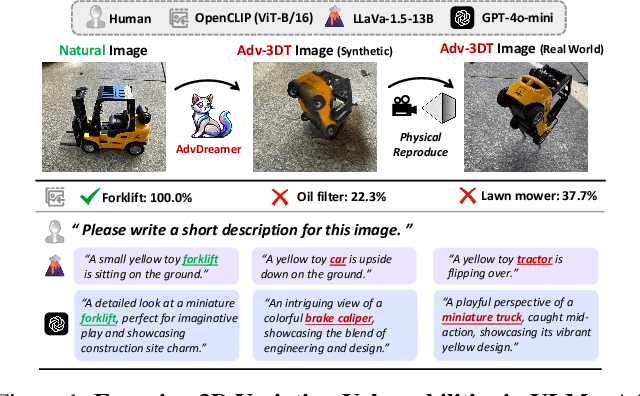
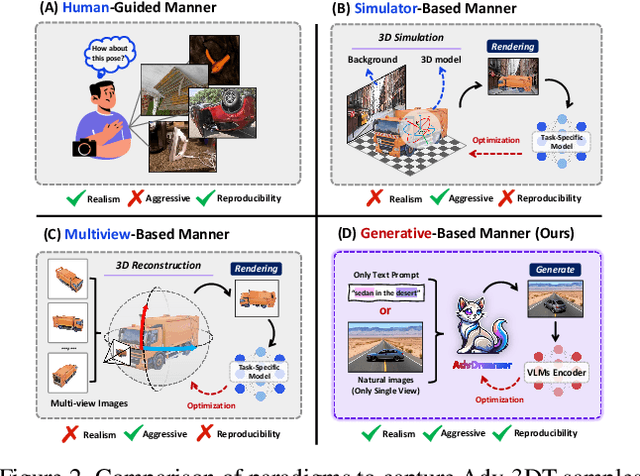
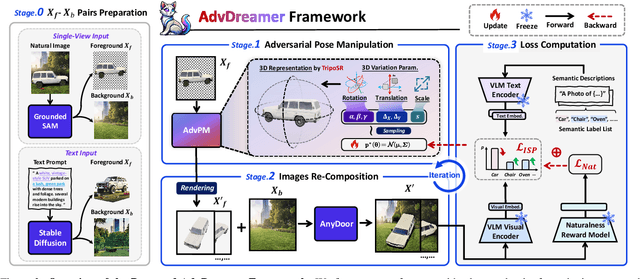
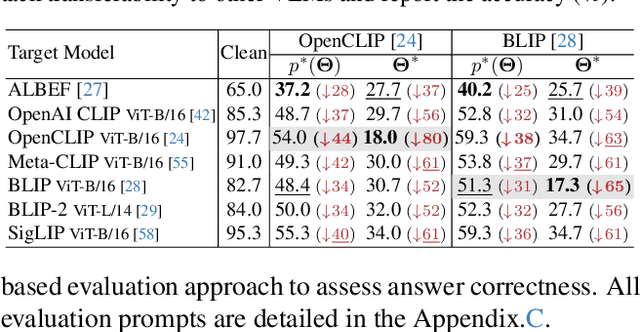
Abstract:Vision Language Models (VLMs) have exhibited remarkable generalization capabilities, yet their robustness in dynamic real-world scenarios remains largely unexplored. To systematically evaluate VLMs' robustness to real-world 3D variations, we propose AdvDreamer, the first framework that generates physically reproducible adversarial 3D transformation (Adv-3DT) samples from single-view images. AdvDreamer integrates advanced generative techniques with two key innovations and aims to characterize the worst-case distributions of 3D variations from natural images. To ensure adversarial effectiveness and method generality, we introduce an Inverse Semantic Probability Objective that executes adversarial optimization on fundamental vision-text alignment spaces, which can be generalizable across different VLM architectures and downstream tasks. To mitigate the distribution discrepancy between generated and real-world samples while maintaining physical reproducibility, we design a Naturalness Reward Model that provides regularization feedback during adversarial optimization, preventing convergence towards hallucinated and unnatural elements. Leveraging AdvDreamer, we establish MM3DTBench, the first VQA dataset for benchmarking VLMs' 3D variations robustness. Extensive evaluations on representative VLMs with diverse architectures highlight that 3D variations in the real world may pose severe threats to model performance across various tasks.
Exploring Aleatoric Uncertainty in Object Detection via Vision Foundation Models
Nov 26, 2024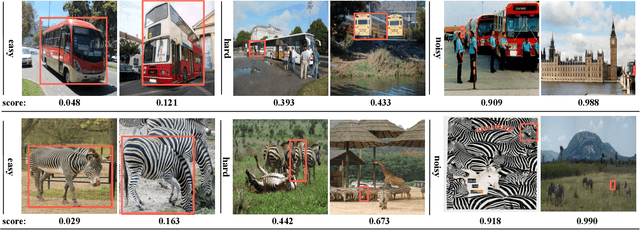
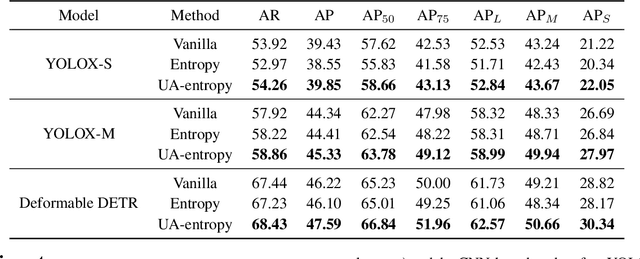
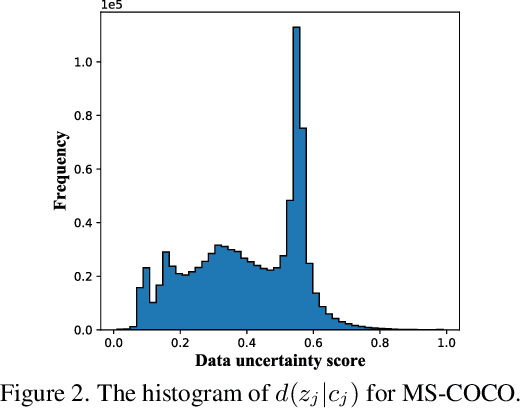
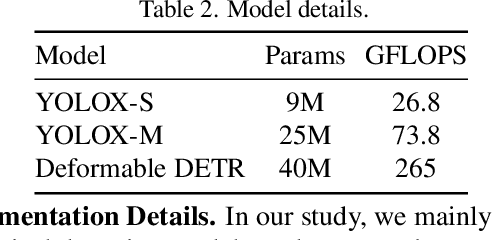
Abstract:Datasets collected from the open world unavoidably suffer from various forms of randomness or noiseness, leading to the ubiquity of aleatoric (data) uncertainty. Quantifying such uncertainty is particularly pivotal for object detection, where images contain multi-scale objects with occlusion, obscureness, and even noisy annotations, in contrast to images with centric and similar-scale objects in classification. This paper suggests modeling and exploiting the uncertainty inherent in object detection data with vision foundation models and develops a data-centric reliable training paradigm. Technically, we propose to estimate the data uncertainty of each object instance based on the feature space of vision foundation models, which are trained on ultra-large-scale datasets and able to exhibit universal data representation. In particular, we assume a mixture-of-Gaussian structure of the object features and devise Mahalanobis distance-based measures to quantify the data uncertainty. Furthermore, we suggest two curial and practical usages of the estimated uncertainty: 1) for defining uncertainty-aware sample filter to abandon noisy and redundant instances to avoid over-fitting, and 2) for defining sample adaptive regularizer to balance easy/hard samples for adaptive training. The estimated aleatoric uncertainty serves as an extra level of annotations of the dataset, so it can be utilized in a plug-and-play manner with any model. Extensive empirical studies verify the effectiveness of the proposed aleatoric uncertainty measure on various advanced detection models and challenging benchmarks.
Scaling Laws for Black box Adversarial Attacks
Nov 25, 2024



Abstract:A longstanding problem of deep learning models is their vulnerability to adversarial examples, which are often generated by applying imperceptible perturbations to natural examples. Adversarial examples exhibit cross-model transferability, enabling to attack black-box models with limited information about their architectures and parameters. Model ensembling is an effective strategy to improve the transferability by attacking multiple surrogate models simultaneously. However, as prior studies usually adopt few models in the ensemble, there remains an open question of whether scaling the number of models can further improve black-box attacks. Inspired by the findings in large foundation models, we investigate the scaling laws of black-box adversarial attacks in this work. By analyzing the relationship between the number of surrogate models and transferability of adversarial examples, we conclude with clear scaling laws, emphasizing the potential of using more surrogate models to enhance adversarial transferability. Extensive experiments verify the claims on standard image classifiers, multimodal large language models, and even proprietary models like GPT-4o, demonstrating consistent scaling effects and impressive attack success rates with more surrogate models. Further studies by visualization indicate that scaled attacks bring better interpretability in semantics, indicating that the common features of models are captured.
Real-world Adversarial Defense against Patch Attacks based on Diffusion Model
Sep 14, 2024Abstract:Adversarial patches present significant challenges to the robustness of deep learning models, making the development of effective defenses become critical for real-world applications. This paper introduces DIFFender, a novel DIFfusion-based DeFender framework that leverages the power of a text-guided diffusion model to counter adversarial patch attacks. At the core of our approach is the discovery of the Adversarial Anomaly Perception (AAP) phenomenon, which enables the diffusion model to accurately detect and locate adversarial patches by analyzing distributional anomalies. DIFFender seamlessly integrates the tasks of patch localization and restoration within a unified diffusion model framework, enhancing defense efficacy through their close interaction. Additionally, DIFFender employs an efficient few-shot prompt-tuning algorithm, facilitating the adaptation of the pre-trained diffusion model to defense tasks without the need for extensive retraining. Our comprehensive evaluation, covering image classification and face recognition tasks, as well as real-world scenarios, demonstrates DIFFender's robust performance against adversarial attacks. The framework's versatility and generalizability across various settings, classifiers, and attack methodologies mark a significant advancement in adversarial patch defense strategies. Except for the popular visible domain, we have identified another advantage of DIFFender: its capability to easily expand into the infrared domain. Consequently, we demonstrate the good flexibility of DIFFender, which can defend against both infrared and visible adversarial patch attacks alternatively using a universal defense framework.
T2VSafetyBench: Evaluating the Safety of Text-to-Video Generative Models
Jul 08, 2024



Abstract:The recent development of Sora leads to a new era in text-to-video (T2V) generation. Along with this comes the rising concern about its security risks. The generated videos may contain illegal or unethical content, and there is a lack of comprehensive quantitative understanding of their safety, posing a challenge to their reliability and practical deployment. Previous evaluations primarily focus on the quality of video generation. While some evaluations of text-to-image models have considered safety, they cover fewer aspects and do not address the unique temporal risk inherent in video generation. To bridge this research gap, we introduce T2VSafetyBench, a new benchmark designed for conducting safety-critical assessments of text-to-video models. We define 12 critical aspects of video generation safety and construct a malicious prompt dataset using LLMs and jailbreaking prompt attacks. Based on our evaluation results, we draw several important findings, including: 1) no single model excels in all aspects, with different models showing various strengths; 2) the correlation between GPT-4 assessments and manual reviews is generally high; 3) there is a trade-off between the usability and safety of text-to-video generative models. This indicates that as the field of video generation rapidly advances, safety risks are set to surge, highlighting the urgency of prioritizing video safety. We hope that T2VSafetyBench can provide insights for better understanding the safety of video generation in the era of generative AI.
 Add to Chrome
Add to Chrome Add to Firefox
Add to Firefox Add to Edge
Add to Edge